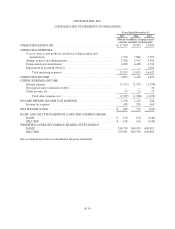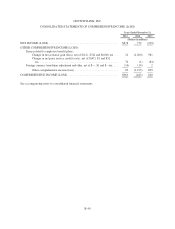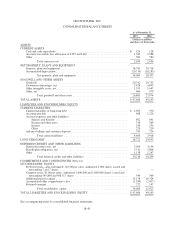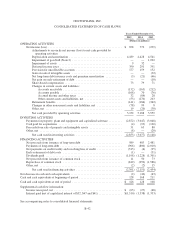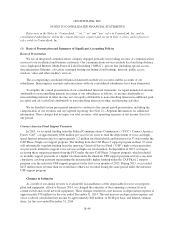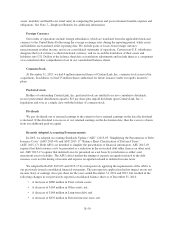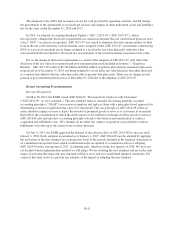CenturyLink 2015 Annual Report Download - page 156
Download and view the complete annual report
Please find page 156 of the 2015 CenturyLink annual report below. You can navigate through the pages in the report by either clicking on the pages listed below, or by using the keyword search tool below to find specific information within the annual report.Property, Plant and Equipment
Property, plant and equipment acquired in connection with our acquisitions was recorded based on its
estimated fair value as of its acquisition date plus the estimated value of any associated legally or contractually
required retirement obligations. Purchased and constructed property, plant and equipment is recorded at cost,
plus the estimated value of any associated legally or contractually required retirement obligations. Property, plant
and equipment is depreciated primarily using the straight-line group method. Under the straight-line group
method, assets dedicated to providing telecommunications services (which comprise the majority of our property,
plant and equipment) that have similar physical characteristics, use and expected useful lives are pooled for
purposes of depreciation and tracking. The equal life group procedure is used to establish each pool’s average
remaining useful life. Generally, under the straight-line group method, when an asset is sold or retired in the
course of normal business activities, the cost is deducted from property, plant and equipment and charged to
accumulated depreciation without recognition of a gain or loss. A gain or loss is recognized in our consolidated
statements of operations only if a disposal is abnormal or unusual. Leasehold improvements are amortized over
the shorter of the useful lives of the assets or the expected lease term. Expenditures for maintenance and repairs
are expensed as incurred. Interest is capitalized during the construction phase of network and other internal-use
capital projects. Employee-related costs for construction of network and other internal use assets are also
capitalized during the construction phase. Property, plant and equipment supplies used internally are carried at
average cost, except for significant individual items for which cost is based on specific identification.
We perform annual internal reviews to evaluate the reasonableness of the depreciable lives for our property,
plant and equipment. Our reviews utilize models that take into account actual usage, physical wear and tear,
replacement history, assumptions about technology evolution and, in certain instances, actuarially determined
probabilities to estimate the remaining useful life of our asset base. Our remaining useful life assessments
anticipate the loss in service value of assets that may precede the physical retirement. Assets shared among many
customers may lose service value as those customers leave the network. However, the asset is not retired until all
customers no longer utilize the asset and we determine there is no alternative use for the asset.
We have asset retirement obligations associated with the legally or contractually required removal of a
limited group of property, plant and equipment assets from leased properties and the disposal of certain
hazardous materials present in our owned properties. When an asset retirement obligation is identified, usually in
association with the acquisition of the asset, we record the fair value of the obligation as a liability. The fair value
of the obligation is also capitalized as property, plant and equipment and then amortized over the estimated
remaining useful life of the associated asset. Where the removal obligation is not legally binding, the net cost to
remove assets is expensed in the period in which the costs are actually incurred.
We review long-lived tangible assets for impairment whenever facts and circumstances indicate that the
carrying amounts of the assets may not be recoverable. For assessment purposes, long-lived assets are grouped
with other assets and liabilities at the lowest level for which identifiable cash flows are largely independent of the
cash flows of other assets and liabilities, absent a material change in operations. An impairment loss is
recognized only if the carrying amount of the asset group is not recoverable and exceeds its fair value.
Recoverability of the asset group to be held and used is assessed by comparing the carrying amount of the asset
group to the estimated undiscounted future net cash flows expected to be generated by the asset group. If the
asset group’s carrying value is not recoverable, an impairment charge is recognized for the amount by which the
carrying amount of the asset group exceeds its fair value. We determine fair values by using a combination of
comparable market values and discounted cash flows, as appropriate.
Goodwill, Customer Relationships and Other Intangible Assets
Intangible assets arising from business combinations, such as goodwill, customer relationships, capitalized
software, trademarks and trade names, are initially recorded at estimated fair value. We amortize customer
relationships primarily over an estimated life of 10 to 15 years, using either the sum-of-the-years-digits or the
B-48



